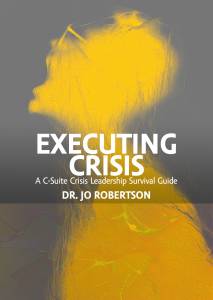Dr. Jo Robertson started her career as a journalist on the top-rated prime-time newscast in the country. It seemed like a logical choice to jump to the other side of the fence to work with companies to help them better understand what the media was going to say about them if they were in a crisis. Most importantly, Robertson teaches them how to stay out of crises in the first place.
With 20 years of experience keeping companies out of crisis, Robertson has plenty of experience working in the business continuity/disaster recovery field.
“When I teach crisis management classes or give seminars, I enjoy seeing heads nod as the concepts start making sense and are getting internalized,” she said.
Robertson said one common misunderstanding in BC/DR is challenging best practice.
“There’s too much repetition of old outdated information that’s no longer relevant,” she said. “If you are new to the profession, it’s up to you to challenge ‘what has always been.’”
She said professionals should ask to see the data when someone claims something is ‘best practice’ because there just isn’t data to support many of these cardinal rules any longer.
This is something Robertson plans to address during her Solutions Track 1 session on March 30 from 10-10:45 a.m. at DRJ Spring 2021.
Robertson’s presentation, titled “Gray Rhinos and Risk Assessments,” will discuss how the COVID-19 pandemic was not a “black swan” – a catastrophic event that came out of the blue that no one saw coming – but was actually a “gray rhino” that had long been predicted but leadership everywhere overlooked it.
“As we move forward from the pandemic to new challenges,” said Robertson, “how do we better ensure we’ve got our eyes open so the next crisis doesn’t hit us unaware?”
Robertson said gray rhinos are high-likelihood-high-impact risks but “we fool ourselves into believing that although they are high-impact risks, they are low-likelihood of happening this year and can be pushed into the moderate risk category for mitigation down the road.”
Fine-tuning the way professionals look at this will require a change of perspective and a new methodology, including reconfiguring the way people do their risk assessments to re-weight them differently.
“Why as risk managers do we insist on the outdated strategy of rating the y-axis, or likelihood, on equal footing with the x-axis, or impact?” Robertson asked. “If we decrease the importance of the likelihood axis and increase the significance of the impact axis, our gray rhinos become red rhinos, clearly in need of mitigation.”
This concept and methodology were first published in DRJ’s Fall 2020 edition and is quickly gaining traction across the industry.
Now, Robertson is encouraging attendees to join her session on March 30 to learn more about how to see an organization’s gray rhinos.
“I’ll show you how to see gray rhinos and plan for them effectively in your organization,” said Robertson.
DRJ Spring 2020 is not the only conference at which Robertson will be presenting. She also presented at DRJ Fall 2020 with “The NEW Rules of Crisis Leadership.”
Robertson loves to interact with those who are attending her sessions, and the back-and-forth discussion always makes the material so much more tangible.
As global director of emergency preparedness for Capital One, Robertson was responsible for orchestrating the creation of a coordinated universal emergency preparedness program and the leadership of 2,500 life safety team members. As director of crisis preparedness for Arkema, she rebuilt and re-energized crisis preparedness initiatives and acted as a trusted advisor to C-Suite executives for France’s leading chemicals producer. At Deloitte Services, she led the national crisis management program for more than 100 offices. As vice president for Marsh Crisis Consulting, she delivered crisis communications planning, media training, real-time support, and complex crisis management exercises for Fortune 500 clients.
Robertson spent the first half of her career as a TV journalist and was responsible for news stories which initiated change at the highest levels of government, including a reversal of policy at the Pentagon.
She has a doctoral degree in crisis management from George Washington University, a master’s degree in journalism from American University, and a bachelor’s degree in communications from Pennsylvania State University.
Robertson is author of “Executing Crisis: A C-Suite Crisis Leadership Survival Guide.”



